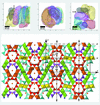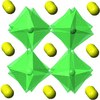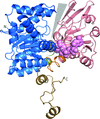issue contents
May 2017 issue

editorial
MATERIALS | COMPUTATION
Recent developments in the structural science of materials and the growing power of computational methods in this field are discussed.
scientific commentaries
CHEMISTRY | CRYSTENG
Three polymorphs of a dichloro-N-salicylideneaniline derivative show visually impressive jumping and sudden blasting behaviours on heating due to phase transitions.
CHEMISTRY | CRYSTENG
The ferroelectric–paraelectric transition in Li0.2Na0.8NbO3 is between two extremely rare perovskite polytypes. How the unprecedented sequence of structures was established shows that even old oxides can play new tricks.
research papers
CHEMISTRY | CRYSTENG
Download citation


Download citation


Acemetacin cocrystals were prepared by melt crystallization and their crystal structures determined by high-resolution powder X-ray diffraction. The difficult to obtain single crystals for the acemetacin family is overcome by structure determination from powder data.
CHEMISTRY | CRYSTENG
Download citation


Download citation


We demonstrate the existence of a novel phase transition sequence in the perovskite Li0.2Na0.8NbO3 at elevated temperature. The rare Glazer tilt system, a+a+c−, is observed in both polar and centrosymmetric polymorphs.
MATERIALS | COMPUTATION
Download citation


Download citation


Denisovite is a rare mineral occurring as fibres typically 200–500 nm in diameter, always characterized by pervasive disorder. Combining X-ray powder diffraction, high-angle annular dark-field scanning transmission electron microscopy imaging and electron diffraction tomography, it was possible to determine the denisovite structure and describe its disorder and polytypism by order–disorder theory. The denisovite structure ranks among the top 1% of the most complex mineral structures known to date.
CHEMISTRY | CRYSTENG
Download citation


Download citation


Among the halogen derivatives of N-salicylideneaniline, polymorphs of the dichloro compound A showed the mechanical response of jumping (Forms I and III) and sudden blasting (Form II) upon heating. This difference is ascribed to the layered packing in Forms I and III such that the thermal stress acts in a unidirectional manner while for the corrugated layer structure of Form II the outcome is blasting because the thermal energy dissipates in different directions.
PHYSICS | FELS
Facilitating the very short and intense pulses from an X-ray laser for the purpose of imaging small bioparticles carries the potential for structure determination at atomic resolution without the need for crystallization. In this study, experimental strategies for this idea are explored based on data collected at the Linac Coherent Light Source from 40 nm virus particles injected into a hard X-ray beam.
BIOLOGY | MEDICINE
Integrated structural biology can yield powerful synergies and maximize the biological information gained. Two examples are described of combining X-ray crystallography with single-crystal resonance Raman and UV–visible spectroscopies to study the functions of haem proteins.
BIOLOGY | MEDICINE
Crystallographic and SAXS studies of S-adenosyl-L-homocysteine hydrolase from Bradyrhizobium elkanii
Tetrameric S-adenosyl-L-homocysteine hydrolase from a nitrogen-fixing bacterium was crystallized in complexes with four different ligands. The crystal structures reveal that there is no simple correlation between the cargo molecule in the active site and the open/closed subunit conformation or the open/shut state of the active-site access gate.
CHEMISTRY | CRYSTENG
The identification of multiple amino-acid coordination sites which can bind to the radiopharmaceutical synthon fac-[Re(CO)3]+ is reported.
PDB reference: hen egg-white lysozyme with bound rhenium, 5nbj
topical reviews
BIOLOGY | MEDICINE
Recent developments allow the extraction of accurate contact predictions from multiple protein-sequence alignments. This review illustrates the manifold ways in which this information may assist the experimental structural biologist.



 journal menu
journal menu




 access
access























